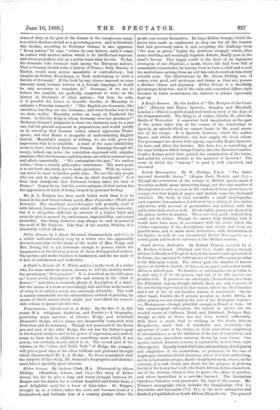South African Butterflies. By Roland Trimen, assisted by J. H.
Bowker, Colonel. (Triibner and Co.)—South Africa, though inferior to Brazil and Tropical Asia in the number and splendour of its forms, has amongst its 1,000 species of butterflies many peculiar to the Ethiopian region. The writer puts the number of known species at 10,000 to 11,000; if this is so, we must confess that South Africa is indeed poor. No families or sub-families are peculiar to it, and only 0 of its 69 genera, and 195 of its 380 species, are peculiar to it. It possesses one sub-family (Nemeobiinre) less than the Ethiopian region, though, indeed, there are only 4 species of the sub-family represented in that region, which has the 5 families and 8 out of the 12 sub-families known to naturalists. On the other hand, besides the-6 genera peculiar to South Africa, 21 other genera are not found in the rest of the Ethiopian region- i.e., Madagascar—though plentiful enough in Brazil or Asia. Of this extra-tropical sub-region, the richest in species are the wooded coasts of Ca,ffraria, Natal, and Zululand ; Delagoa Bay, though as rich as these, has not been worked sufficiently. Still, there is much that is striking in the South African Rhopalocera, much that is wonderful and beautiful,—the splendour of some of the forms, or their marvellous adaptation to circumstances, as in the imitation of the hue of vegetation, and the still more marvellous mimicry shown by some forms. One species, indeed, Amauris echeria, is imitated by no less than eight other species. Equally wonderful is the extraordinary development and adaptation of the haustellum, or proboscis, in the case of Amphonyx cluentius (South America), where it is nine inches long, and in Achrerontius atropos, death's-head hawk-moth, where, on the contrary, it is stiff, broad, and short, for the purpose of piercing the lid of the honey-bee's cell; the South African Achim chameleon, one of the Nocture, which is able to pierce the skins of peaches, and whose haustellem is a saw-like bayonet. The Australian Ophideres fullonica even penetrates the rind of the orange. Mr. Trimen's monograph, which includes the Nymphalidie (Vol. I.), Eryciniclis, and Lyczenida3 (Vol. II.), is the most exhaustive and finished yet published on South African Rhopalocera. The general character, locality, habit, and colouring are described with a minute accuracy and skill that leave nothing to be desired. The coloured plates are the most beautiful and finished that we have seen in any similar publication. Some fifty species are figured. Two fine plates of larvte and pupas of some fifteen species are also given, as well as a plate on wing-neuration. Every information relative to locality and habits is given.



































 Previous page
Previous page